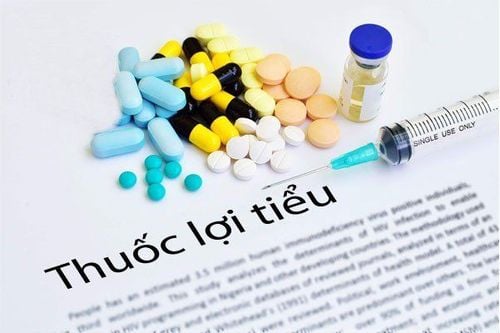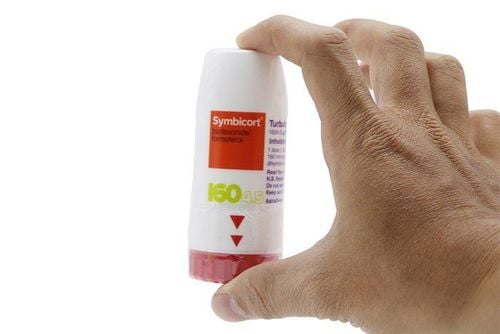This is an automatically translated article.
Opesalbu is a selective beta-adrenergic bronchodilator that relaxes bronchial smooth muscle. It is used orally to treat shortness of breath caused by bronchospasm in children and adults.1. What are the effects of Opesalbu?
Opesalbu medicine has the main ingredient Salbutamol (in the form of Salbutamol sulfate) 2mg / 5ml, prepared in the form of syrup bottled 60ml.
Salbutamol sulfate is a beta-adrenergic agonist that selectively acts on β2 receptors on bronchial muscles and has little or no effect on cardiac receptors at therapeutic doses. Due to its selective action on bronchial smooth muscle, causing bronchodilation and little effect on the cardiovascular system, Salbutamol is suitable for the treatment of bronchospasm in patients with concomitant heart disease or hypertension. .
The drug is also effective in preventing the release of histamine from IgE-sensitive lung mast cells. Helps prevent mooth part of allergic reactions that cause asthma attacks.
2. Indications and contraindications of the drug Opesalbu
Indications: Opesalbu is indicated for use in the following cases:
Used in bronchospasm in bronchial asthma, chronic bronchitis, spasmodic bronchitis and emphysema for children and people Adults prefer to take medicine in liquid form. Prophylaxis of bronchial asthma. Opesalbu is contraindicated in the following cases:
Allergy to Salbutamol or other ingredients in the drug's ingredients. Contraindicated to use Salbutamol in fixed combination with Ipratropium bromide for people with a history of hypersensitivity to soy lecithin or to foods related to soy, peanuts. Patients with severe heart disease.
3. Dosage and how to take Opesalbu
How to use: The drug is taken orally. Take an appropriate amount of the solution as directed and drink it directly or dilute it. This syrup should not be diluted with BP syrup or sorbitol solution as this may precipitate cellulose.
Dosage:
Adults: The usual effective dose of Opesalbul is 10ml (4mg salbutamol), taken 3 or 4 times a day. If an adequate bronchodilator effect is not achieved, a single dose may be increased gradually up to 20 mL (8 mg salbutamol). For some patients, an adequate bronchodilator effect is achieved with a dose of Opesalbu of 5 ml (2 mg salbutamol), taken 3 or 4 times daily. Children: For children from 2 to 6 years old: Take from 2.5 to 5ml of syrup (1 - 2mg salbutamol), 3 or 4 times a day. For children 6-12 years old: Take 5ml syrup (2mg salbutamol), take 3 or 4 times a day. Over 12 years: Take 5 to 10 ml of syrup (2 - 4 mg of salbutamol), 3 or 4 times a day. Elderly patients: In elderly patients or in patients who are unusually sensitive to beta adrenergic stimulants, treatment should be initiated at a lower than recommended therapeutic dose of 5 mL syrup (2 mg salbutamol), orally 3 or 4 times/day. Overdose:
The most common manifestations and symptoms of overdosage with Salbutamol are transient beta-agonist pharmacological manifestations; hypokalemia may occur; lactic acidosis has also been reported; Nausea, vomiting, and hyperglycemia have been reported, mainly in children and with oral overdose. Treatment: If signs of an overdose of Salbutamol appear, you should be taken to a medical facility. Treatment is based on clinical symptoms and follow-up.
4. Side effects of the drug Opesalbu
Undesirable effects of the drug Opesalbu you may encounter when taking the drug include:
Common side effects: Palpitations, tachycardia; trembling fingers. Uncommon: Epigastric pain, epigastric pain, anorexia, myalgia, somnolence, sleep disturbance. Rare: Bronchospasm, causing dry mouth, throat irritation, cough and hoarseness; Hypokalemia, cramps; irritability, headache; Hypersensitivity reactions such as angioedema, urticaria, hypotension, and collapse. When taking the drug, if you notice any side effects, you should notify your doctor for advice.
5. Notes when using Opesalbu
Salbutamol must be used with caution in patients with hypersensitivity to sympathomimetic amines, hyperthyroidism, diabetes mellitus, epilepsy or cardiovascular disease including coronary insufficiency, arrhythmias, hypertension. The management of asthma is often a stepwise program, which should monitor the patient's response clinically and with pulmonary function tests. If the patient does not control symptoms, it indicates deterioration of asthma control. In those cases, the patient needs to be examined to reevaluate the treatment regimen. Poor asthma control or sudden or progressive worsening of the disease is life-threatening and should consider initiation of treatment or an increase in the dose of corticosteroid therapy. Patients who are considered to be at risk for severe asthma attacks can have daily peak flow testing. When using, it is recommended that patients should not arbitrarily increase the dose or increase the frequency of use when the response is reduced or the duration of effect is reduced, but before changing, it is necessary to consult a doctor. Cardiovascular effects may occur with the use of sympathomimetic agents, including salbutamol. Rare cases of myocardial ischemia or symptoms suggesting worsening of heart disease have also been reported. Attention should be paid to evaluating symptoms such as dyspnea and chest pain, and if present, should be examined and evaluated. Particular caution should be exercised in patients with acute severe asthma because of the risk of hypokalemia, which may be increased when co-administered with xanthine derivatives, steroids, diuretics and because hypoxia. Serum potassium should be monitored in these cases. Like other beta adrenergic receptor agonists, Salbutamol may induce reversible metabolic changes, such as increased blood sugar. There have been reports of ketoacidosis in patients with diabetes. Concomitant use with corticosteroids may cause an exaggerated increase in this effect, so extreme care should be taken in the patient's glycemic index. Pregnancy: Consider use of this drug during pregnancy only when the expected benefit to the mother outweighs any possible risk to the fetus. In post-marketing experience, rare cases of various congenital abnormalities including cleft palate and limb malformations have been reported in the children of patients treated with salbutamol. Lactation: Because salbutamol is likely to be excreted in human milk, nursing mothers should not use the drug, only if the expected benefit to the mother outweighs any risk when administered to the nursing mother. young. In a joint study, beta-agonists were excreted in human milk, which may result in tachycardia in the nursing infant and increased blood glucose levels. Use caution when taking the drug. Drug Interactions: Increased risk of cardiovascular side effects when salbutamol is injected with atomoxetin; Salbutamol has the potential to cause a decrease in plasma digoxin concentrations; Some other drugs also cause interactions, so tell your doctor about the drugs you are taking. Storage: store this syrup at a temperature not exceeding 30 degrees Celsius, protected from light. Keep out of reach of children. Do not use the medicine more than 1 month after opening and after the expiry date. Opesalbu is used under the direction of a doctor, you only take it as directed and do not change the dose on your own. Clinical signs and peak flow should be monitored periodically during dosing, to ensure optimal disease control.













